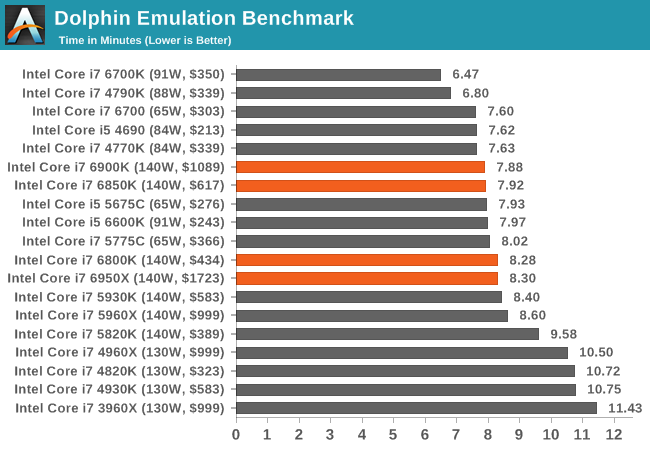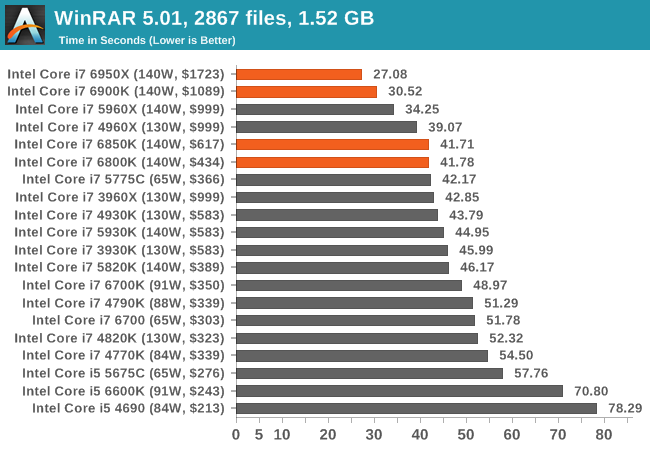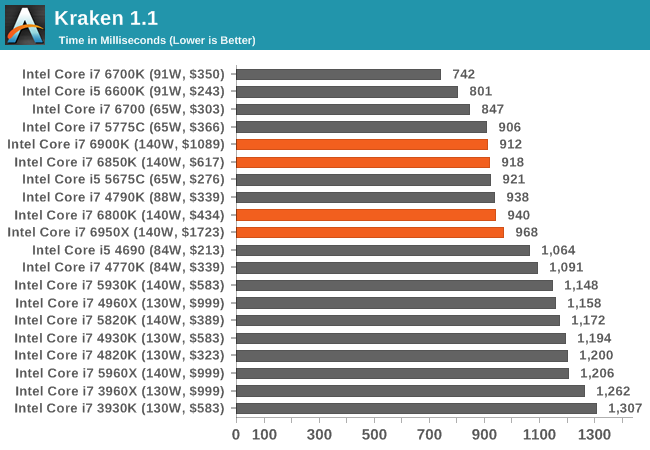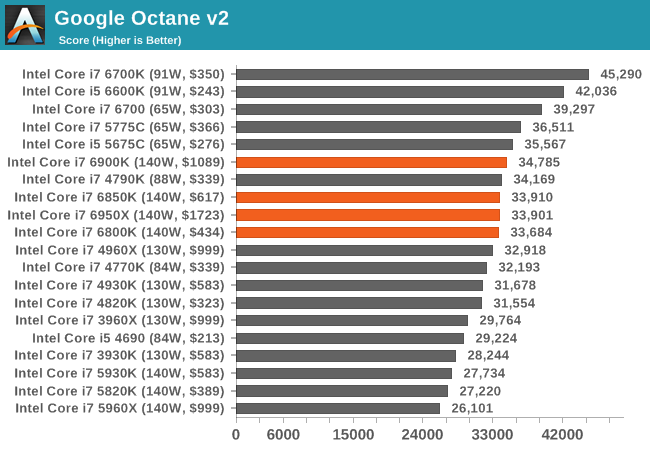The Intel Broadwell-E Review: Core i7-6950X, i7-6900K, i7-6850K and i7-6800K Tested
by Ian Cutress on May 31, 2016 2:01 AM EST- Posted in
- CPUs
- Intel
- Enterprise
- Prosumer
- X99
- 14nm
- Broadwell-E
- HEDT
Office Performance
Dolphin Benchmark: link
Many emulators are often bound by single thread CPU performance, and general reports tended to suggest that Haswell provided a significant boost to emulator performance. This benchmark runs a Wii program that ray traces a complex 3D scene inside the Dolphin Wii emulator. Performance on this benchmark is a good proxy of the speed of Dolphin CPU emulation, which is an intensive single core task using most aspects of a CPU. Results are given in minutes, where the Wii itself scores 17.53 minutes.

WinRAR 5.0.1: link
Our WinRAR test from 2013 is updated to the latest version of WinRAR at the start of 2014. We compress a set of 2867 files across 320 folders totaling 1.52 GB in size – 95% of these files are small typical website files, and the rest (90% of the size) are small 30 second 720p videos.

3D Particle Movement
3DPM is a self-penned benchmark, taking basic 3D movement algorithms used in Brownian Motion simulations and testing them for speed. High floating point performance, MHz and IPC wins in the single thread version, whereas the multithread version has to handle the threads and loves more cores.


Web Benchmarks
On the lower end processors, general usability is a big factor of experience, especially as we move into the HTML5 era of web browsing. As browsing moves into a multithreaded arena and web applications get more advanced, it is all the more important to have an appropriate level of performance.
Mozilla Kraken 1.1

Google Octane v2











205 Comments
View All Comments
piroroadkill - Tuesday, May 31, 2016 - link
Shitty pricing, lame increases in performance.I really hope Zen lights a fire under their ass.
aggrokalle - Tuesday, May 31, 2016 - link
Hi Ian, is the Intel Thermal Solution TS13A compatible with the thinner package of the Broadwell-E? I didn't find any informations on the intel website. Don't wonna break my shiny new toy :pGodofmosquitos - Tuesday, May 31, 2016 - link
Honestly - as the article itself mentions, the EE-line of CPU's have just fallen too far behind to be considered serious options for enthusiasts. At least imo. I still have a 980X clocked at 4GHz. And it runs everything with stellar performance. That was the last time Intel had an EE-CPU which was ahead of the curve. Also, as PCI-E 4.0 will seemingly require a new platform, due to lacking backwards compatibility of PCI-E 4.0 cards with 3.0 slots, I seriously cannot see anything justifying an upgrade before '18, when PCI-E 4.0 is out, we're on 10nm, and Intel Optane disks are readily available.Godofmosquitos - Tuesday, May 31, 2016 - link
Or well, for "the average" enthusiast at least ^^Impulses - Tuesday, May 31, 2016 - link
What I really don't get is why the 6800K is still saddled with a lower lane count... Aren't the price hikes and the lag to market enough of an HEDT differentiator? Is the lower lane count something that helps yields?They've gone backwards, from having an attractively priced 5820K that could lure some Z170/6700K buyers to basically making HEDT as irrelevant as possible unless you absolutely need the extra cores.
A lot of enthusiasts that don't NEED 6+ cores but COULD benefit from it (photo/video work in the side etc) would be all over a more attractive and less ignored HEDT lineup.
rhysiam - Wednesday, June 1, 2016 - link
I totally agree. I'm due for an upgrade and put myself exactly in that category of photo + video work on the side and being "lured" towards a 5820K. But the price hikes, lag to market and practically 0 performance seems to have pushed the "HEDT" line from enthusiast to niche. Reading this review I don't want anything to do with it.We've waited almost 2 years since the Haswell-E launch and the "update" offers significantly worse price/performance ratios.
Especially with Skylake having plenty of PCIe lanes, with the right motherboard you're covered for 2 graphics cards (or 1 plus a RAID controller), several PCIe SSDs and a 10GBps NIC... plenty for the foreseeable future. Intel is making the cost of these 6+ core CPUs (both in terms of $$s and in the sacrifice you have to make in single threaded performance) larger and larger.
My worry is that pushing up HEDT prices will allow them to bump up the prices of high end mainstream CPUs. Let's see how much the overclockable Kaby Lake i7 costs shall we? I sure hope Zen can shake things up.
adamod - Wednesday, June 1, 2016 - link
market segmentation....no other reasonmapesdhs - Thursday, June 9, 2016 - link
Doubly backwards given the 4820K was a 40-lane chip, whereas the 5820K isn't. It means a 4820K/X79 can do things for gaming with SLI/CF (and still have lanes for storage and other stuff) which a 5820K and 6800K can't.rodmunch69 - Tuesday, May 31, 2016 - link
I had a 980x and then upgraded to a 3930k... 4 years ago. The 2 extra cores were great and useful, but otherwise there wasn't a big difference between the chips. Reading this it doesn't seem like the base 6800k is really much of an upgrade over a 3930k. I've been wanting to upgrade if there was a reason to do so, but Intel again isn't giving me one. One thing however with the 980x is the motherboards and the related chipsets, that's where you'd see a big difference going with something like a 6800k and it would be the reason I'd move off a 980x, but only if I was looking for a reason to move.rodmunch69 - Tuesday, May 31, 2016 - link
I've had a 3930k for 4 years now and I still don't feel much of a need to upgrade. What is going on with Intel? They seriously need a competitor to kick them in the rear and push them ahead.